Obesity Management Strategies for Learning Disability Nursing
VerifiedAdded on 2021/04/16
|16
|4734
|105
Essay
AI Summary
This essay addresses the research question of how to manage obesity among individuals with learning disabilities. It examines the clinical effectiveness of weight management interventions, analyzing their feasibility, appropriateness, meaningfulness, and effectiveness based on evidence from databases like Medline, Science Direct, and CINHAL. The essay discusses studies such as those by Spanos et al. (2013), Beeken et al. (2013), Willems et al. (2016), Doherty et al. (2017), and Harris et al. (2018), focusing on interventions like multi-component approaches and the Shape Up-LD program. It identifies best practices, including providing information on diet, physical activity, and behavior change. The essay also analyzes factors that promote or inhibit implementation, such as resource allocation and rapport-building, and applies Lewin’s Change Management Model to illustrate how to implement change, highlighting the involvement of service users and stakeholders. The conclusion summarizes the key points and emphasizes the importance of evidence-based practice in learning disability nursing to improve the quality of life for individuals with learning disabilities.
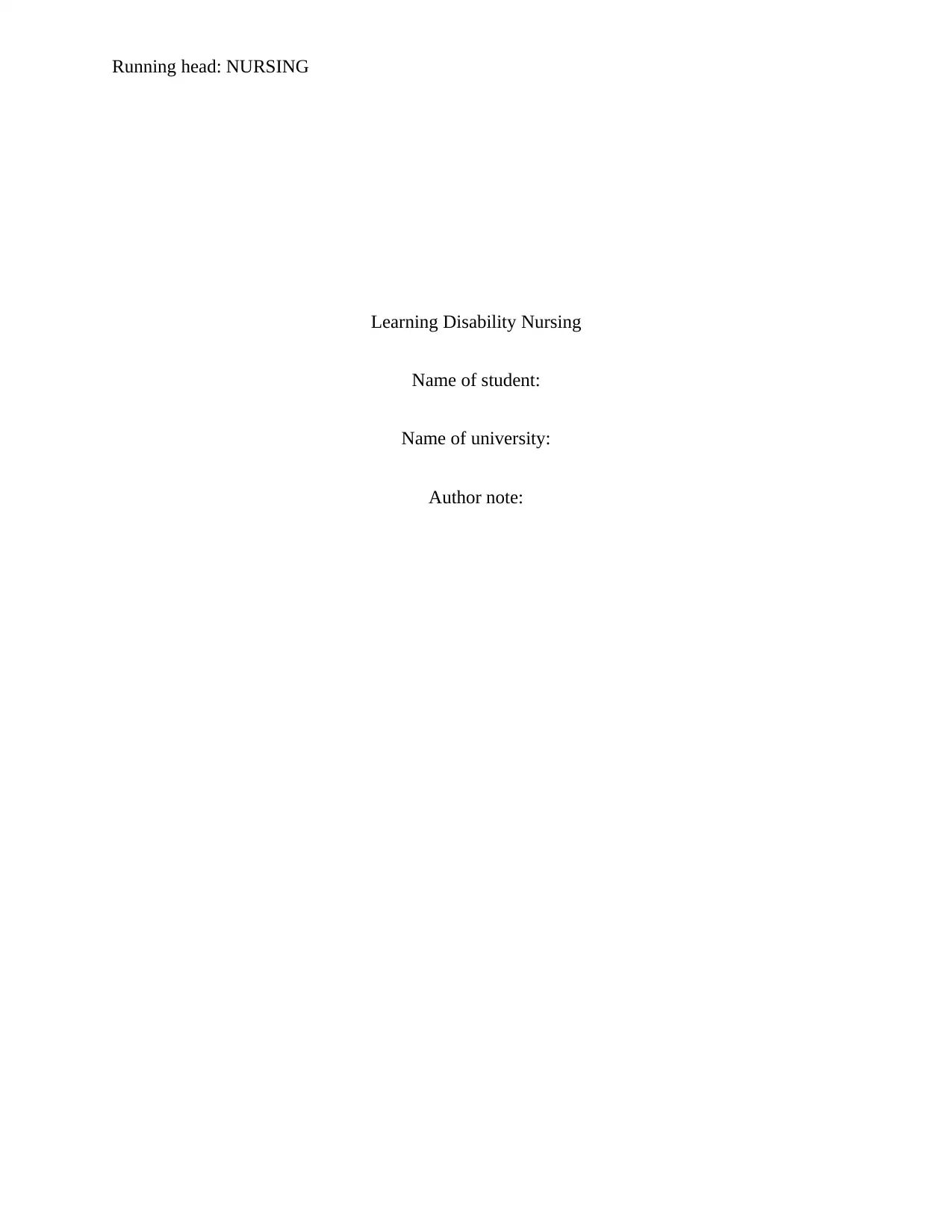
Running head: NURSING
Learning Disability Nursing
Name of student:
Name of university:
Author note:
Learning Disability Nursing
Name of student:
Name of university:
Author note:
Paraphrase This Document
Need a fresh take? Get an instant paraphrase of this document with our AI Paraphraser
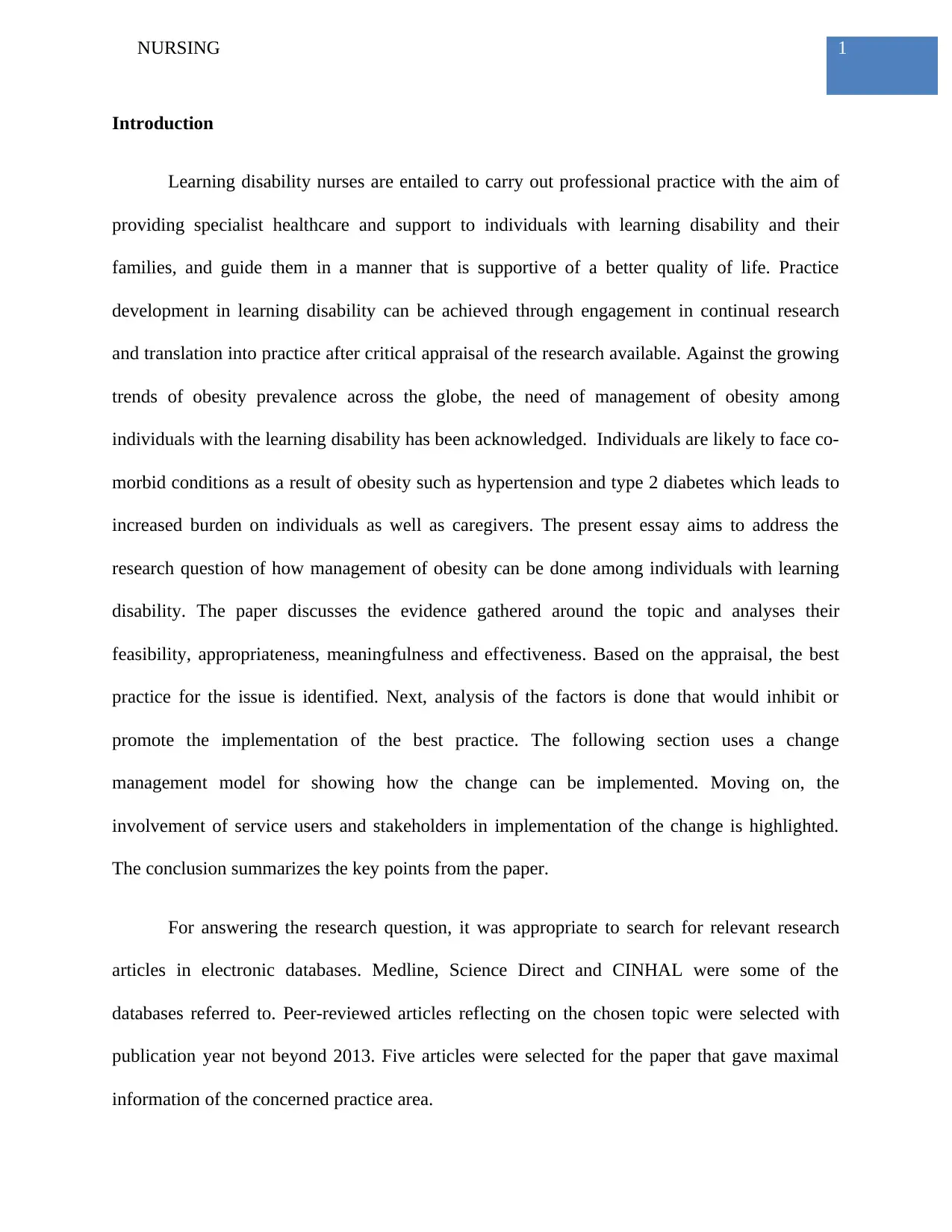
1NURSING
Introduction
Learning disability nurses are entailed to carry out professional practice with the aim of
providing specialist healthcare and support to individuals with learning disability and their
families, and guide them in a manner that is supportive of a better quality of life. Practice
development in learning disability can be achieved through engagement in continual research
and translation into practice after critical appraisal of the research available. Against the growing
trends of obesity prevalence across the globe, the need of management of obesity among
individuals with the learning disability has been acknowledged. Individuals are likely to face co-
morbid conditions as a result of obesity such as hypertension and type 2 diabetes which leads to
increased burden on individuals as well as caregivers. The present essay aims to address the
research question of how management of obesity can be done among individuals with learning
disability. The paper discusses the evidence gathered around the topic and analyses their
feasibility, appropriateness, meaningfulness and effectiveness. Based on the appraisal, the best
practice for the issue is identified. Next, analysis of the factors is done that would inhibit or
promote the implementation of the best practice. The following section uses a change
management model for showing how the change can be implemented. Moving on, the
involvement of service users and stakeholders in implementation of the change is highlighted.
The conclusion summarizes the key points from the paper.
For answering the research question, it was appropriate to search for relevant research
articles in electronic databases. Medline, Science Direct and CINHAL were some of the
databases referred to. Peer-reviewed articles reflecting on the chosen topic were selected with
publication year not beyond 2013. Five articles were selected for the paper that gave maximal
information of the concerned practice area.
Introduction
Learning disability nurses are entailed to carry out professional practice with the aim of
providing specialist healthcare and support to individuals with learning disability and their
families, and guide them in a manner that is supportive of a better quality of life. Practice
development in learning disability can be achieved through engagement in continual research
and translation into practice after critical appraisal of the research available. Against the growing
trends of obesity prevalence across the globe, the need of management of obesity among
individuals with the learning disability has been acknowledged. Individuals are likely to face co-
morbid conditions as a result of obesity such as hypertension and type 2 diabetes which leads to
increased burden on individuals as well as caregivers. The present essay aims to address the
research question of how management of obesity can be done among individuals with learning
disability. The paper discusses the evidence gathered around the topic and analyses their
feasibility, appropriateness, meaningfulness and effectiveness. Based on the appraisal, the best
practice for the issue is identified. Next, analysis of the factors is done that would inhibit or
promote the implementation of the best practice. The following section uses a change
management model for showing how the change can be implemented. Moving on, the
involvement of service users and stakeholders in implementation of the change is highlighted.
The conclusion summarizes the key points from the paper.
For answering the research question, it was appropriate to search for relevant research
articles in electronic databases. Medline, Science Direct and CINHAL were some of the
databases referred to. Peer-reviewed articles reflecting on the chosen topic were selected with
publication year not beyond 2013. Five articles were selected for the paper that gave maximal
information of the concerned practice area.
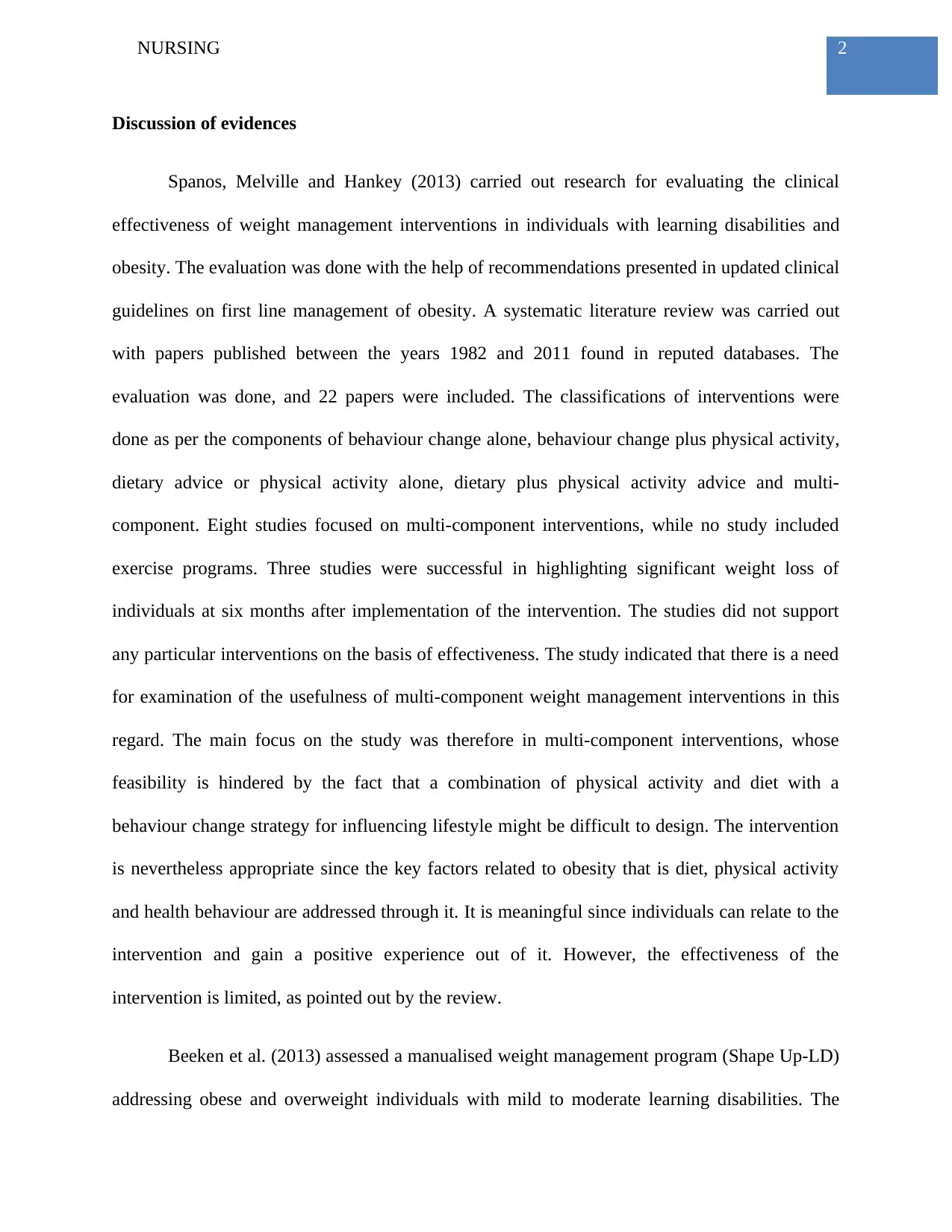
2NURSING
Discussion of evidences
Spanos, Melville and Hankey (2013) carried out research for evaluating the clinical
effectiveness of weight management interventions in individuals with learning disabilities and
obesity. The evaluation was done with the help of recommendations presented in updated clinical
guidelines on first line management of obesity. A systematic literature review was carried out
with papers published between the years 1982 and 2011 found in reputed databases. The
evaluation was done, and 22 papers were included. The classifications of interventions were
done as per the components of behaviour change alone, behaviour change plus physical activity,
dietary advice or physical activity alone, dietary plus physical activity advice and multi-
component. Eight studies focused on multi-component interventions, while no study included
exercise programs. Three studies were successful in highlighting significant weight loss of
individuals at six months after implementation of the intervention. The studies did not support
any particular interventions on the basis of effectiveness. The study indicated that there is a need
for examination of the usefulness of multi-component weight management interventions in this
regard. The main focus on the study was therefore in multi-component interventions, whose
feasibility is hindered by the fact that a combination of physical activity and diet with a
behaviour change strategy for influencing lifestyle might be difficult to design. The intervention
is nevertheless appropriate since the key factors related to obesity that is diet, physical activity
and health behaviour are addressed through it. It is meaningful since individuals can relate to the
intervention and gain a positive experience out of it. However, the effectiveness of the
intervention is limited, as pointed out by the review.
Beeken et al. (2013) assessed a manualised weight management program (Shape Up-LD)
addressing obese and overweight individuals with mild to moderate learning disabilities. The
Discussion of evidences
Spanos, Melville and Hankey (2013) carried out research for evaluating the clinical
effectiveness of weight management interventions in individuals with learning disabilities and
obesity. The evaluation was done with the help of recommendations presented in updated clinical
guidelines on first line management of obesity. A systematic literature review was carried out
with papers published between the years 1982 and 2011 found in reputed databases. The
evaluation was done, and 22 papers were included. The classifications of interventions were
done as per the components of behaviour change alone, behaviour change plus physical activity,
dietary advice or physical activity alone, dietary plus physical activity advice and multi-
component. Eight studies focused on multi-component interventions, while no study included
exercise programs. Three studies were successful in highlighting significant weight loss of
individuals at six months after implementation of the intervention. The studies did not support
any particular interventions on the basis of effectiveness. The study indicated that there is a need
for examination of the usefulness of multi-component weight management interventions in this
regard. The main focus on the study was therefore in multi-component interventions, whose
feasibility is hindered by the fact that a combination of physical activity and diet with a
behaviour change strategy for influencing lifestyle might be difficult to design. The intervention
is nevertheless appropriate since the key factors related to obesity that is diet, physical activity
and health behaviour are addressed through it. It is meaningful since individuals can relate to the
intervention and gain a positive experience out of it. However, the effectiveness of the
intervention is limited, as pointed out by the review.
Beeken et al. (2013) assessed a manualised weight management program (Shape Up-LD)
addressing obese and overweight individuals with mild to moderate learning disabilities. The
⊘ This is a preview!⊘
Do you want full access?
Subscribe today to unlock all pages.

Trusted by 1+ million students worldwide
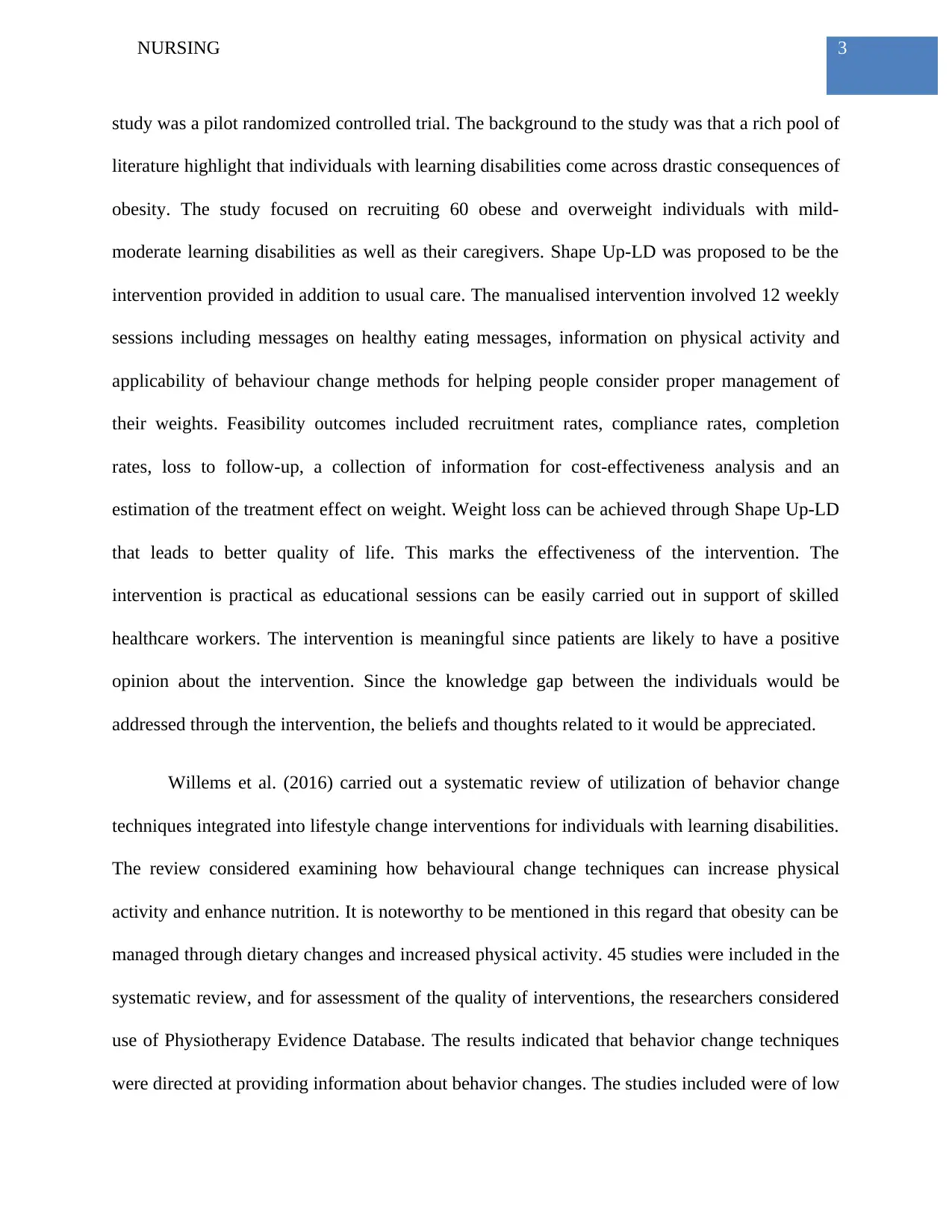
3NURSING
study was a pilot randomized controlled trial. The background to the study was that a rich pool of
literature highlight that individuals with learning disabilities come across drastic consequences of
obesity. The study focused on recruiting 60 obese and overweight individuals with mild-
moderate learning disabilities as well as their caregivers. Shape Up-LD was proposed to be the
intervention provided in addition to usual care. The manualised intervention involved 12 weekly
sessions including messages on healthy eating messages, information on physical activity and
applicability of behaviour change methods for helping people consider proper management of
their weights. Feasibility outcomes included recruitment rates, compliance rates, completion
rates, loss to follow-up, a collection of information for cost-effectiveness analysis and an
estimation of the treatment effect on weight. Weight loss can be achieved through Shape Up-LD
that leads to better quality of life. This marks the effectiveness of the intervention. The
intervention is practical as educational sessions can be easily carried out in support of skilled
healthcare workers. The intervention is meaningful since patients are likely to have a positive
opinion about the intervention. Since the knowledge gap between the individuals would be
addressed through the intervention, the beliefs and thoughts related to it would be appreciated.
Willems et al. (2016) carried out a systematic review of utilization of behavior change
techniques integrated into lifestyle change interventions for individuals with learning disabilities.
The review considered examining how behavioural change techniques can increase physical
activity and enhance nutrition. It is noteworthy to be mentioned in this regard that obesity can be
managed through dietary changes and increased physical activity. 45 studies were included in the
systematic review, and for assessment of the quality of interventions, the researchers considered
use of Physiotherapy Evidence Database. The results indicated that behavior change techniques
were directed at providing information about behavior changes. The studies included were of low
study was a pilot randomized controlled trial. The background to the study was that a rich pool of
literature highlight that individuals with learning disabilities come across drastic consequences of
obesity. The study focused on recruiting 60 obese and overweight individuals with mild-
moderate learning disabilities as well as their caregivers. Shape Up-LD was proposed to be the
intervention provided in addition to usual care. The manualised intervention involved 12 weekly
sessions including messages on healthy eating messages, information on physical activity and
applicability of behaviour change methods for helping people consider proper management of
their weights. Feasibility outcomes included recruitment rates, compliance rates, completion
rates, loss to follow-up, a collection of information for cost-effectiveness analysis and an
estimation of the treatment effect on weight. Weight loss can be achieved through Shape Up-LD
that leads to better quality of life. This marks the effectiveness of the intervention. The
intervention is practical as educational sessions can be easily carried out in support of skilled
healthcare workers. The intervention is meaningful since patients are likely to have a positive
opinion about the intervention. Since the knowledge gap between the individuals would be
addressed through the intervention, the beliefs and thoughts related to it would be appreciated.
Willems et al. (2016) carried out a systematic review of utilization of behavior change
techniques integrated into lifestyle change interventions for individuals with learning disabilities.
The review considered examining how behavioural change techniques can increase physical
activity and enhance nutrition. It is noteworthy to be mentioned in this regard that obesity can be
managed through dietary changes and increased physical activity. 45 studies were included in the
systematic review, and for assessment of the quality of interventions, the researchers considered
use of Physiotherapy Evidence Database. The results indicated that behavior change techniques
were directed at providing information about behavior changes. The studies included were of low
Paraphrase This Document
Need a fresh take? Get an instant paraphrase of this document with our AI Paraphraser
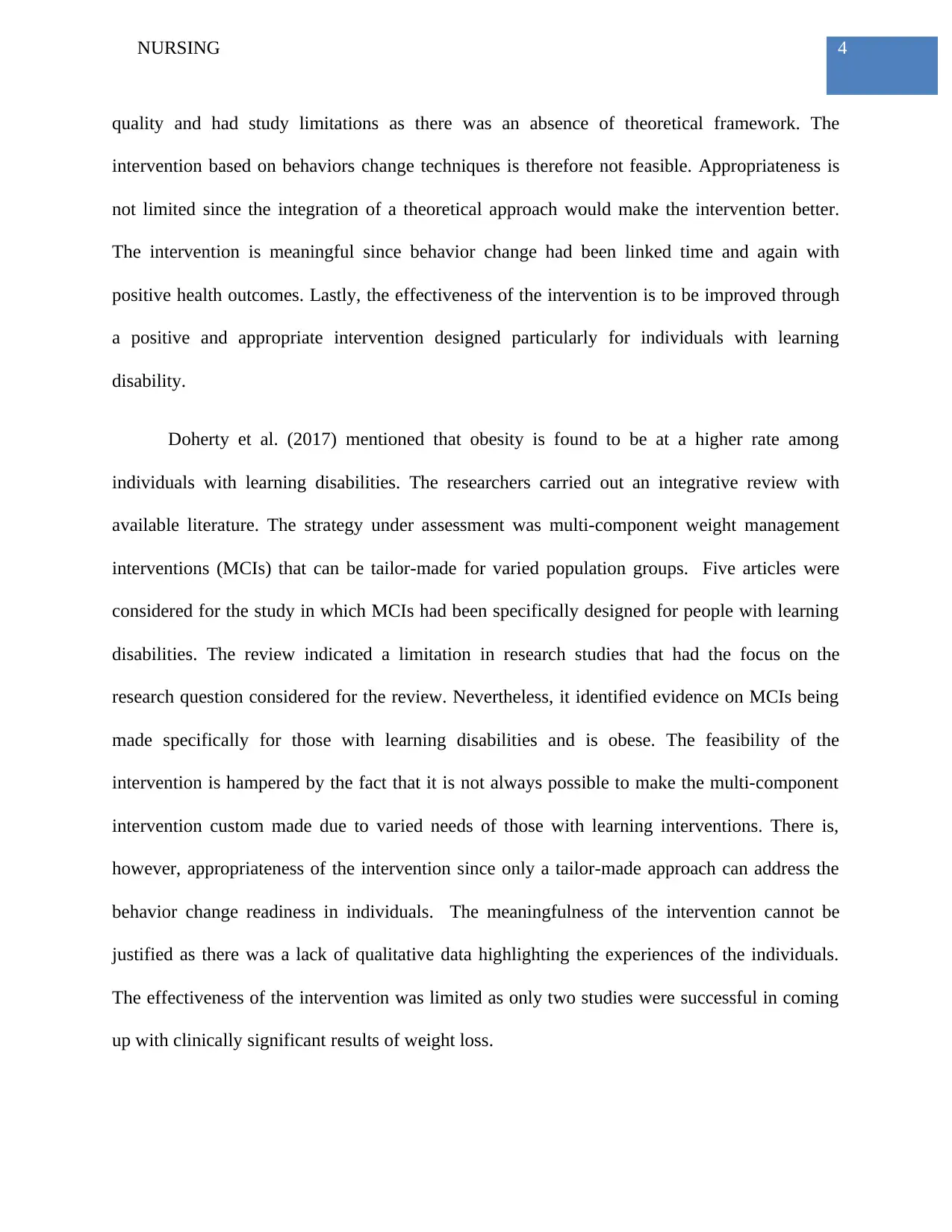
4NURSING
quality and had study limitations as there was an absence of theoretical framework. The
intervention based on behaviors change techniques is therefore not feasible. Appropriateness is
not limited since the integration of a theoretical approach would make the intervention better.
The intervention is meaningful since behavior change had been linked time and again with
positive health outcomes. Lastly, the effectiveness of the intervention is to be improved through
a positive and appropriate intervention designed particularly for individuals with learning
disability.
Doherty et al. (2017) mentioned that obesity is found to be at a higher rate among
individuals with learning disabilities. The researchers carried out an integrative review with
available literature. The strategy under assessment was multi-component weight management
interventions (MCIs) that can be tailor-made for varied population groups. Five articles were
considered for the study in which MCIs had been specifically designed for people with learning
disabilities. The review indicated a limitation in research studies that had the focus on the
research question considered for the review. Nevertheless, it identified evidence on MCIs being
made specifically for those with learning disabilities and is obese. The feasibility of the
intervention is hampered by the fact that it is not always possible to make the multi-component
intervention custom made due to varied needs of those with learning interventions. There is,
however, appropriateness of the intervention since only a tailor-made approach can address the
behavior change readiness in individuals. The meaningfulness of the intervention cannot be
justified as there was a lack of qualitative data highlighting the experiences of the individuals.
The effectiveness of the intervention was limited as only two studies were successful in coming
up with clinically significant results of weight loss.
quality and had study limitations as there was an absence of theoretical framework. The
intervention based on behaviors change techniques is therefore not feasible. Appropriateness is
not limited since the integration of a theoretical approach would make the intervention better.
The intervention is meaningful since behavior change had been linked time and again with
positive health outcomes. Lastly, the effectiveness of the intervention is to be improved through
a positive and appropriate intervention designed particularly for individuals with learning
disability.
Doherty et al. (2017) mentioned that obesity is found to be at a higher rate among
individuals with learning disabilities. The researchers carried out an integrative review with
available literature. The strategy under assessment was multi-component weight management
interventions (MCIs) that can be tailor-made for varied population groups. Five articles were
considered for the study in which MCIs had been specifically designed for people with learning
disabilities. The review indicated a limitation in research studies that had the focus on the
research question considered for the review. Nevertheless, it identified evidence on MCIs being
made specifically for those with learning disabilities and is obese. The feasibility of the
intervention is hampered by the fact that it is not always possible to make the multi-component
intervention custom made due to varied needs of those with learning interventions. There is,
however, appropriateness of the intervention since only a tailor-made approach can address the
behavior change readiness in individuals. The meaningfulness of the intervention cannot be
justified as there was a lack of qualitative data highlighting the experiences of the individuals.
The effectiveness of the intervention was limited as only two studies were successful in coming
up with clinically significant results of weight loss.
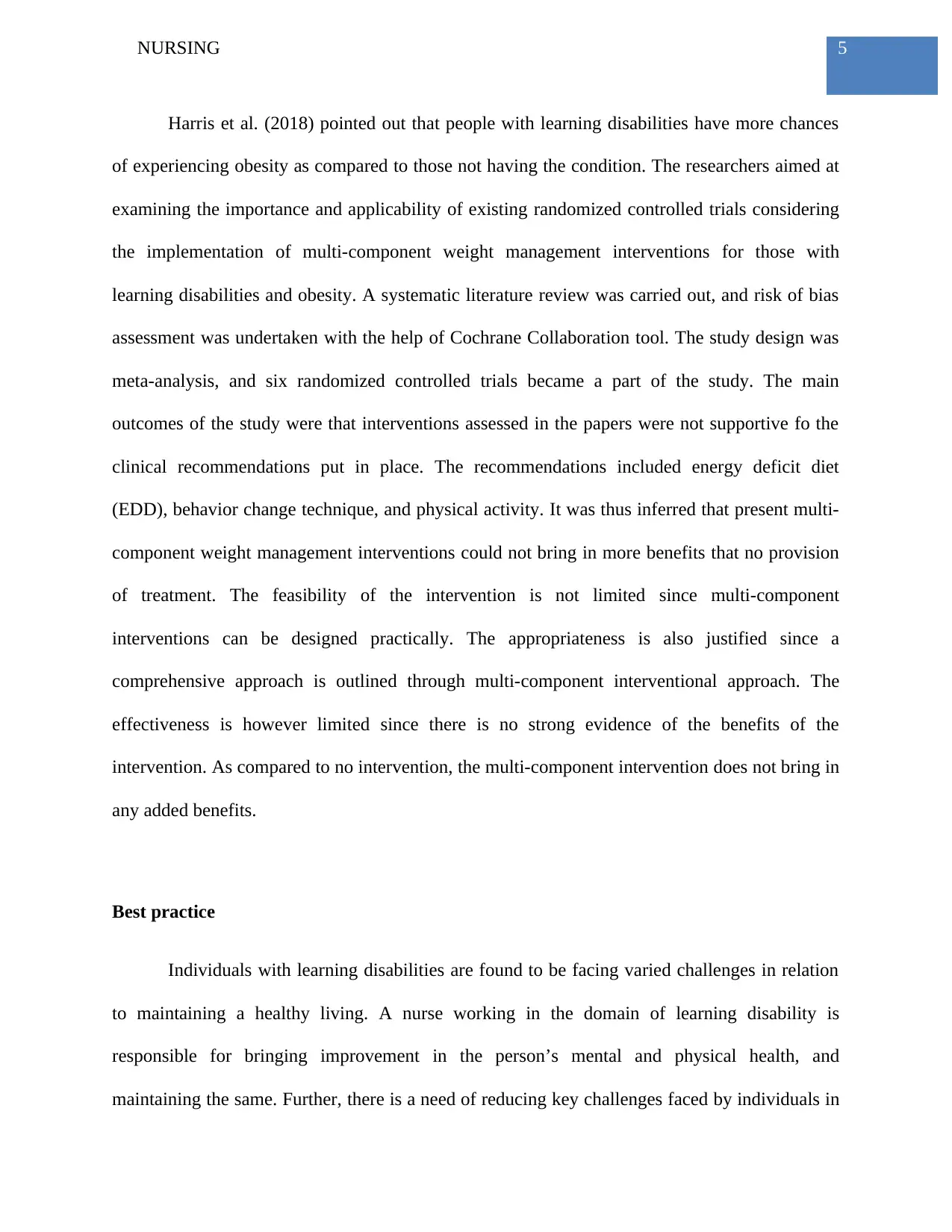
5NURSING
Harris et al. (2018) pointed out that people with learning disabilities have more chances
of experiencing obesity as compared to those not having the condition. The researchers aimed at
examining the importance and applicability of existing randomized controlled trials considering
the implementation of multi-component weight management interventions for those with
learning disabilities and obesity. A systematic literature review was carried out, and risk of bias
assessment was undertaken with the help of Cochrane Collaboration tool. The study design was
meta-analysis, and six randomized controlled trials became a part of the study. The main
outcomes of the study were that interventions assessed in the papers were not supportive fo the
clinical recommendations put in place. The recommendations included energy deficit diet
(EDD), behavior change technique, and physical activity. It was thus inferred that present multi-
component weight management interventions could not bring in more benefits that no provision
of treatment. The feasibility of the intervention is not limited since multi-component
interventions can be designed practically. The appropriateness is also justified since a
comprehensive approach is outlined through multi-component interventional approach. The
effectiveness is however limited since there is no strong evidence of the benefits of the
intervention. As compared to no intervention, the multi-component intervention does not bring in
any added benefits.
Best practice
Individuals with learning disabilities are found to be facing varied challenges in relation
to maintaining a healthy living. A nurse working in the domain of learning disability is
responsible for bringing improvement in the person’s mental and physical health, and
maintaining the same. Further, there is a need of reducing key challenges faced by individuals in
Harris et al. (2018) pointed out that people with learning disabilities have more chances
of experiencing obesity as compared to those not having the condition. The researchers aimed at
examining the importance and applicability of existing randomized controlled trials considering
the implementation of multi-component weight management interventions for those with
learning disabilities and obesity. A systematic literature review was carried out, and risk of bias
assessment was undertaken with the help of Cochrane Collaboration tool. The study design was
meta-analysis, and six randomized controlled trials became a part of the study. The main
outcomes of the study were that interventions assessed in the papers were not supportive fo the
clinical recommendations put in place. The recommendations included energy deficit diet
(EDD), behavior change technique, and physical activity. It was thus inferred that present multi-
component weight management interventions could not bring in more benefits that no provision
of treatment. The feasibility of the intervention is not limited since multi-component
interventions can be designed practically. The appropriateness is also justified since a
comprehensive approach is outlined through multi-component interventional approach. The
effectiveness is however limited since there is no strong evidence of the benefits of the
intervention. As compared to no intervention, the multi-component intervention does not bring in
any added benefits.
Best practice
Individuals with learning disabilities are found to be facing varied challenges in relation
to maintaining a healthy living. A nurse working in the domain of learning disability is
responsible for bringing improvement in the person’s mental and physical health, and
maintaining the same. Further, there is a need of reducing key challenges faced by individuals in
⊘ This is a preview!⊘
Do you want full access?
Subscribe today to unlock all pages.

Trusted by 1+ million students worldwide
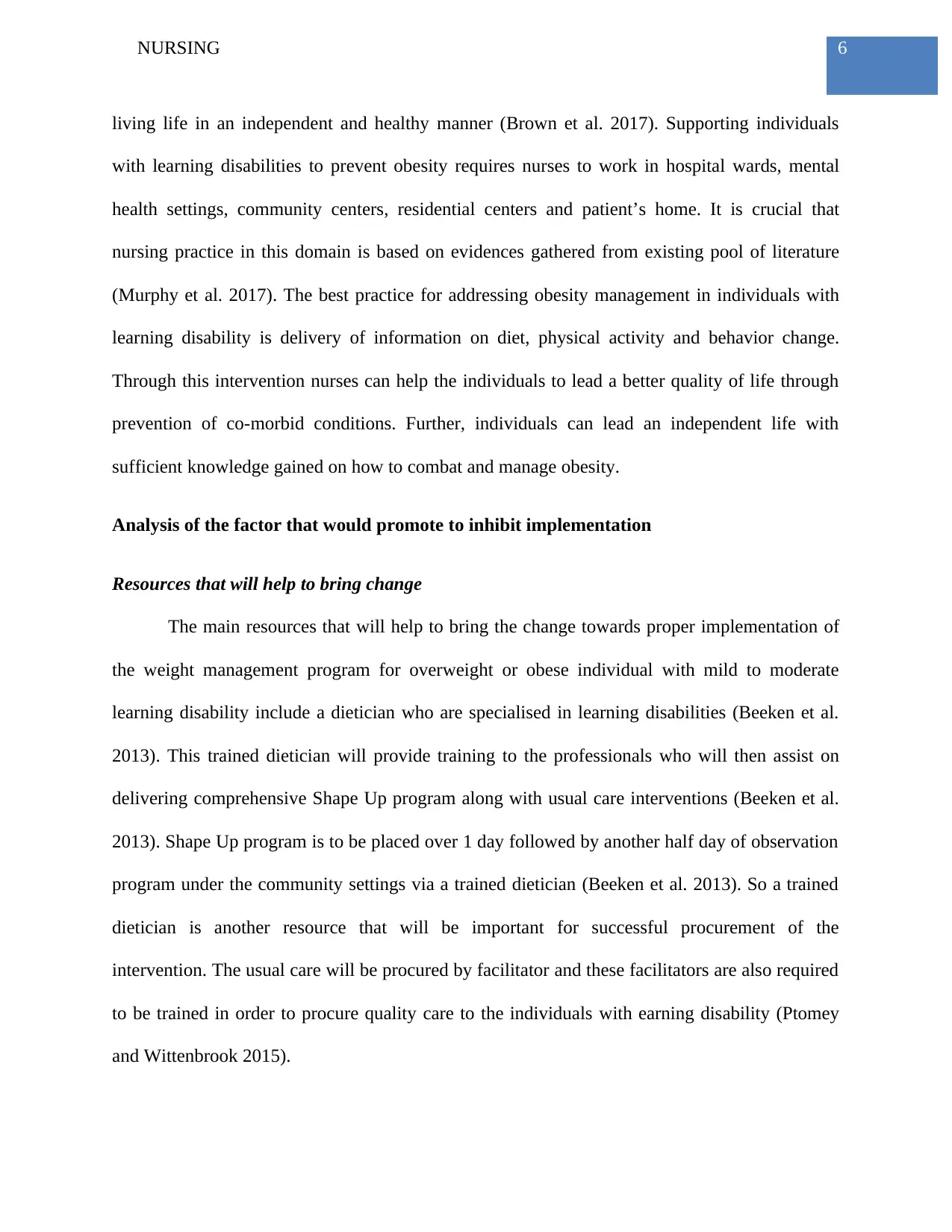
6NURSING
living life in an independent and healthy manner (Brown et al. 2017). Supporting individuals
with learning disabilities to prevent obesity requires nurses to work in hospital wards, mental
health settings, community centers, residential centers and patient’s home. It is crucial that
nursing practice in this domain is based on evidences gathered from existing pool of literature
(Murphy et al. 2017). The best practice for addressing obesity management in individuals with
learning disability is delivery of information on diet, physical activity and behavior change.
Through this intervention nurses can help the individuals to lead a better quality of life through
prevention of co-morbid conditions. Further, individuals can lead an independent life with
sufficient knowledge gained on how to combat and manage obesity.
Analysis of the factor that would promote to inhibit implementation
Resources that will help to bring change
The main resources that will help to bring the change towards proper implementation of
the weight management program for overweight or obese individual with mild to moderate
learning disability include a dietician who are specialised in learning disabilities (Beeken et al.
2013). This trained dietician will provide training to the professionals who will then assist on
delivering comprehensive Shape Up program along with usual care interventions (Beeken et al.
2013). Shape Up program is to be placed over 1 day followed by another half day of observation
program under the community settings via a trained dietician (Beeken et al. 2013). So a trained
dietician is another resource that will be important for successful procurement of the
intervention. The usual care will be procured by facilitator and these facilitators are also required
to be trained in order to procure quality care to the individuals with earning disability (Ptomey
and Wittenbrook 2015).
living life in an independent and healthy manner (Brown et al. 2017). Supporting individuals
with learning disabilities to prevent obesity requires nurses to work in hospital wards, mental
health settings, community centers, residential centers and patient’s home. It is crucial that
nursing practice in this domain is based on evidences gathered from existing pool of literature
(Murphy et al. 2017). The best practice for addressing obesity management in individuals with
learning disability is delivery of information on diet, physical activity and behavior change.
Through this intervention nurses can help the individuals to lead a better quality of life through
prevention of co-morbid conditions. Further, individuals can lead an independent life with
sufficient knowledge gained on how to combat and manage obesity.
Analysis of the factor that would promote to inhibit implementation
Resources that will help to bring change
The main resources that will help to bring the change towards proper implementation of
the weight management program for overweight or obese individual with mild to moderate
learning disability include a dietician who are specialised in learning disabilities (Beeken et al.
2013). This trained dietician will provide training to the professionals who will then assist on
delivering comprehensive Shape Up program along with usual care interventions (Beeken et al.
2013). Shape Up program is to be placed over 1 day followed by another half day of observation
program under the community settings via a trained dietician (Beeken et al. 2013). So a trained
dietician is another resource that will be important for successful procurement of the
intervention. The usual care will be procured by facilitator and these facilitators are also required
to be trained in order to procure quality care to the individuals with earning disability (Ptomey
and Wittenbrook 2015).
Paraphrase This Document
Need a fresh take? Get an instant paraphrase of this document with our AI Paraphraser
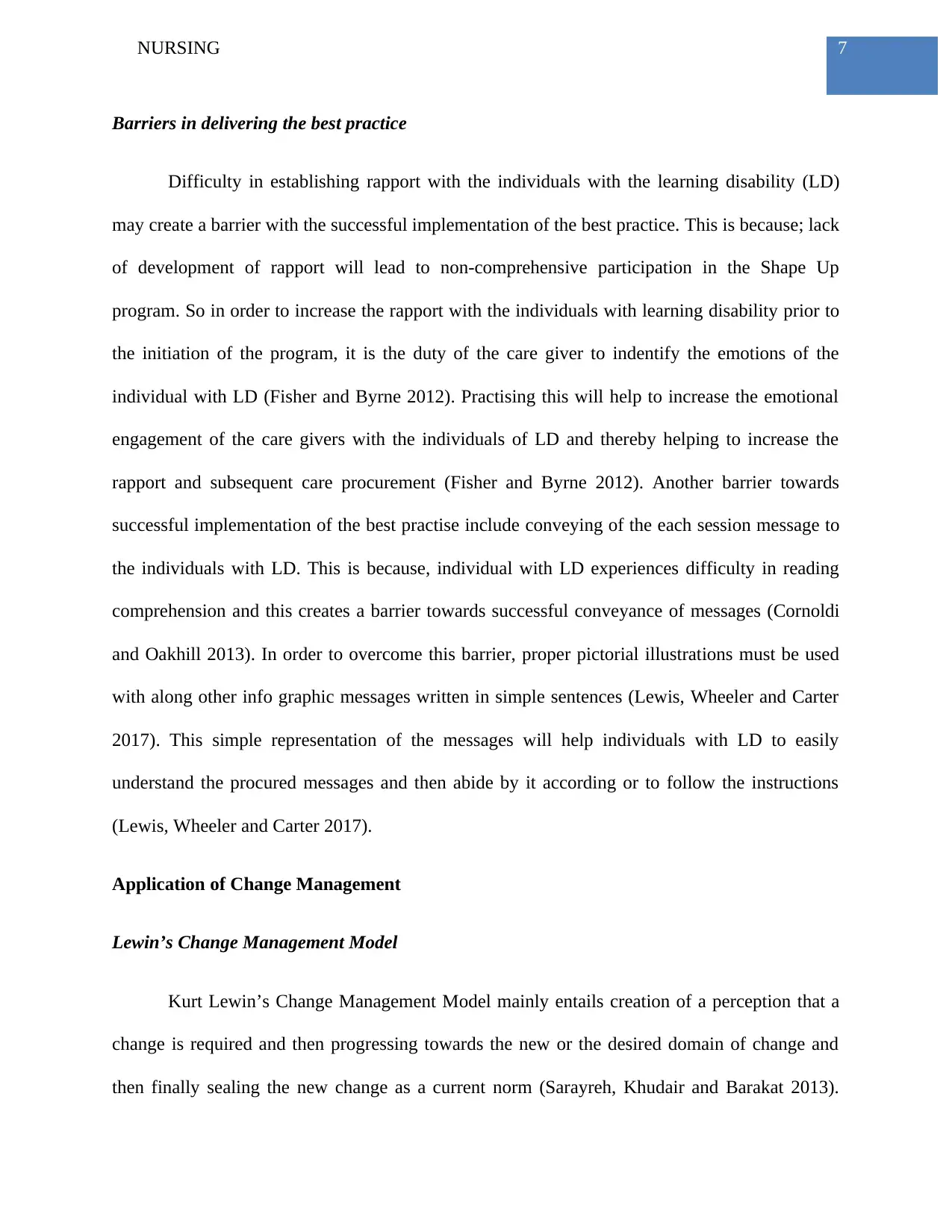
7NURSING
Barriers in delivering the best practice
Difficulty in establishing rapport with the individuals with the learning disability (LD)
may create a barrier with the successful implementation of the best practice. This is because; lack
of development of rapport will lead to non-comprehensive participation in the Shape Up
program. So in order to increase the rapport with the individuals with learning disability prior to
the initiation of the program, it is the duty of the care giver to indentify the emotions of the
individual with LD (Fisher and Byrne 2012). Practising this will help to increase the emotional
engagement of the care givers with the individuals of LD and thereby helping to increase the
rapport and subsequent care procurement (Fisher and Byrne 2012). Another barrier towards
successful implementation of the best practise include conveying of the each session message to
the individuals with LD. This is because, individual with LD experiences difficulty in reading
comprehension and this creates a barrier towards successful conveyance of messages (Cornoldi
and Oakhill 2013). In order to overcome this barrier, proper pictorial illustrations must be used
with along other info graphic messages written in simple sentences (Lewis, Wheeler and Carter
2017). This simple representation of the messages will help individuals with LD to easily
understand the procured messages and then abide by it according or to follow the instructions
(Lewis, Wheeler and Carter 2017).
Application of Change Management
Lewin’s Change Management Model
Kurt Lewin’s Change Management Model mainly entails creation of a perception that a
change is required and then progressing towards the new or the desired domain of change and
then finally sealing the new change as a current norm (Sarayreh, Khudair and Barakat 2013).
Barriers in delivering the best practice
Difficulty in establishing rapport with the individuals with the learning disability (LD)
may create a barrier with the successful implementation of the best practice. This is because; lack
of development of rapport will lead to non-comprehensive participation in the Shape Up
program. So in order to increase the rapport with the individuals with learning disability prior to
the initiation of the program, it is the duty of the care giver to indentify the emotions of the
individual with LD (Fisher and Byrne 2012). Practising this will help to increase the emotional
engagement of the care givers with the individuals of LD and thereby helping to increase the
rapport and subsequent care procurement (Fisher and Byrne 2012). Another barrier towards
successful implementation of the best practise include conveying of the each session message to
the individuals with LD. This is because, individual with LD experiences difficulty in reading
comprehension and this creates a barrier towards successful conveyance of messages (Cornoldi
and Oakhill 2013). In order to overcome this barrier, proper pictorial illustrations must be used
with along other info graphic messages written in simple sentences (Lewis, Wheeler and Carter
2017). This simple representation of the messages will help individuals with LD to easily
understand the procured messages and then abide by it according or to follow the instructions
(Lewis, Wheeler and Carter 2017).
Application of Change Management
Lewin’s Change Management Model
Kurt Lewin’s Change Management Model mainly entails creation of a perception that a
change is required and then progressing towards the new or the desired domain of change and
then finally sealing the new change as a current norm (Sarayreh, Khudair and Barakat 2013).
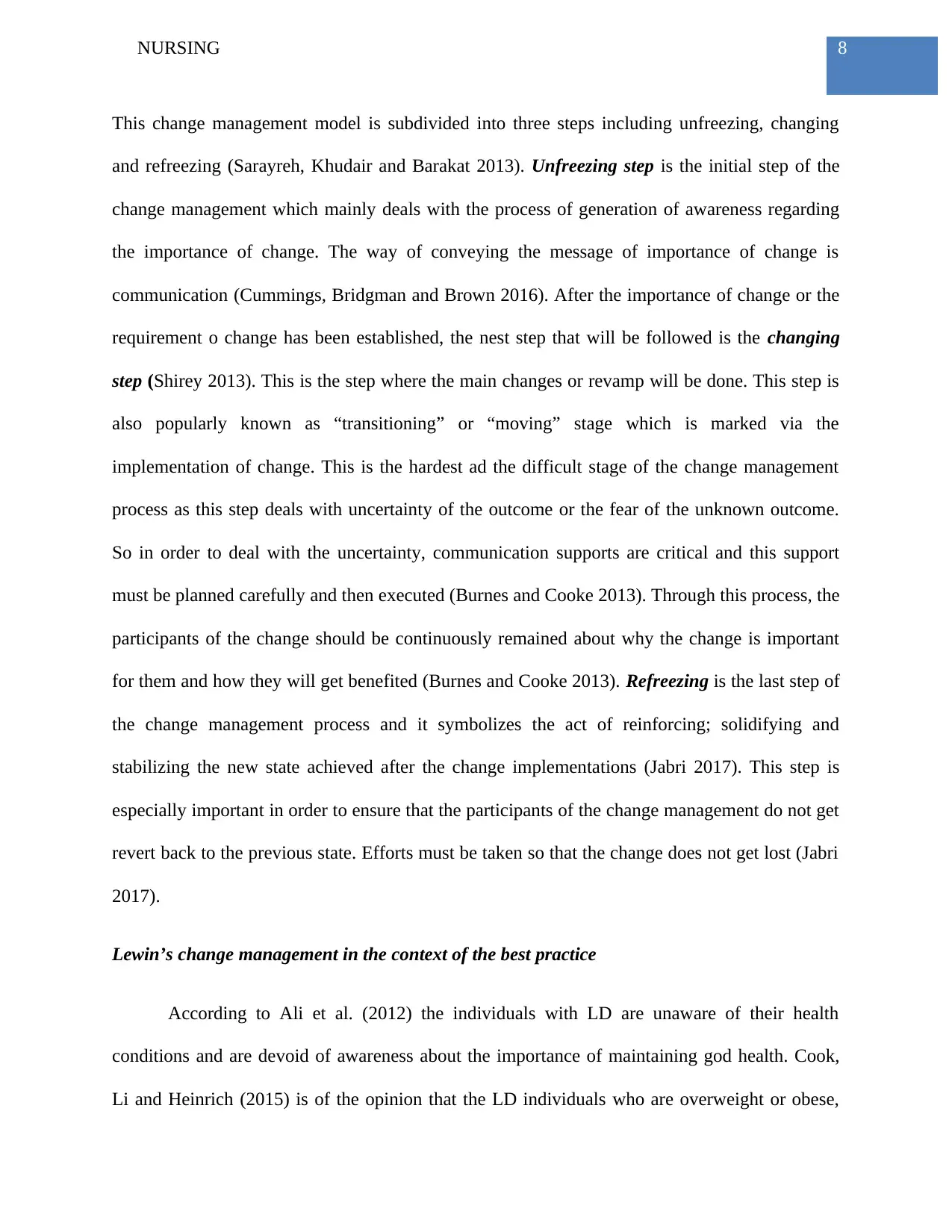
8NURSING
This change management model is subdivided into three steps including unfreezing, changing
and refreezing (Sarayreh, Khudair and Barakat 2013). Unfreezing step is the initial step of the
change management which mainly deals with the process of generation of awareness regarding
the importance of change. The way of conveying the message of importance of change is
communication (Cummings, Bridgman and Brown 2016). After the importance of change or the
requirement o change has been established, the nest step that will be followed is the changing
step (Shirey 2013). This is the step where the main changes or revamp will be done. This step is
also popularly known as “transitioning” or “moving” stage which is marked via the
implementation of change. This is the hardest ad the difficult stage of the change management
process as this step deals with uncertainty of the outcome or the fear of the unknown outcome.
So in order to deal with the uncertainty, communication supports are critical and this support
must be planned carefully and then executed (Burnes and Cooke 2013). Through this process, the
participants of the change should be continuously remained about why the change is important
for them and how they will get benefited (Burnes and Cooke 2013). Refreezing is the last step of
the change management process and it symbolizes the act of reinforcing; solidifying and
stabilizing the new state achieved after the change implementations (Jabri 2017). This step is
especially important in order to ensure that the participants of the change management do not get
revert back to the previous state. Efforts must be taken so that the change does not get lost (Jabri
2017).
Lewin’s change management in the context of the best practice
According to Ali et al. (2012) the individuals with LD are unaware of their health
conditions and are devoid of awareness about the importance of maintaining god health. Cook,
Li and Heinrich (2015) is of the opinion that the LD individuals who are overweight or obese,
This change management model is subdivided into three steps including unfreezing, changing
and refreezing (Sarayreh, Khudair and Barakat 2013). Unfreezing step is the initial step of the
change management which mainly deals with the process of generation of awareness regarding
the importance of change. The way of conveying the message of importance of change is
communication (Cummings, Bridgman and Brown 2016). After the importance of change or the
requirement o change has been established, the nest step that will be followed is the changing
step (Shirey 2013). This is the step where the main changes or revamp will be done. This step is
also popularly known as “transitioning” or “moving” stage which is marked via the
implementation of change. This is the hardest ad the difficult stage of the change management
process as this step deals with uncertainty of the outcome or the fear of the unknown outcome.
So in order to deal with the uncertainty, communication supports are critical and this support
must be planned carefully and then executed (Burnes and Cooke 2013). Through this process, the
participants of the change should be continuously remained about why the change is important
for them and how they will get benefited (Burnes and Cooke 2013). Refreezing is the last step of
the change management process and it symbolizes the act of reinforcing; solidifying and
stabilizing the new state achieved after the change implementations (Jabri 2017). This step is
especially important in order to ensure that the participants of the change management do not get
revert back to the previous state. Efforts must be taken so that the change does not get lost (Jabri
2017).
Lewin’s change management in the context of the best practice
According to Ali et al. (2012) the individuals with LD are unaware of their health
conditions and are devoid of awareness about the importance of maintaining god health. Cook,
Li and Heinrich (2015) is of the opinion that the LD individuals who are overweight or obese,
⊘ This is a preview!⊘
Do you want full access?
Subscribe today to unlock all pages.

Trusted by 1+ million students worldwide
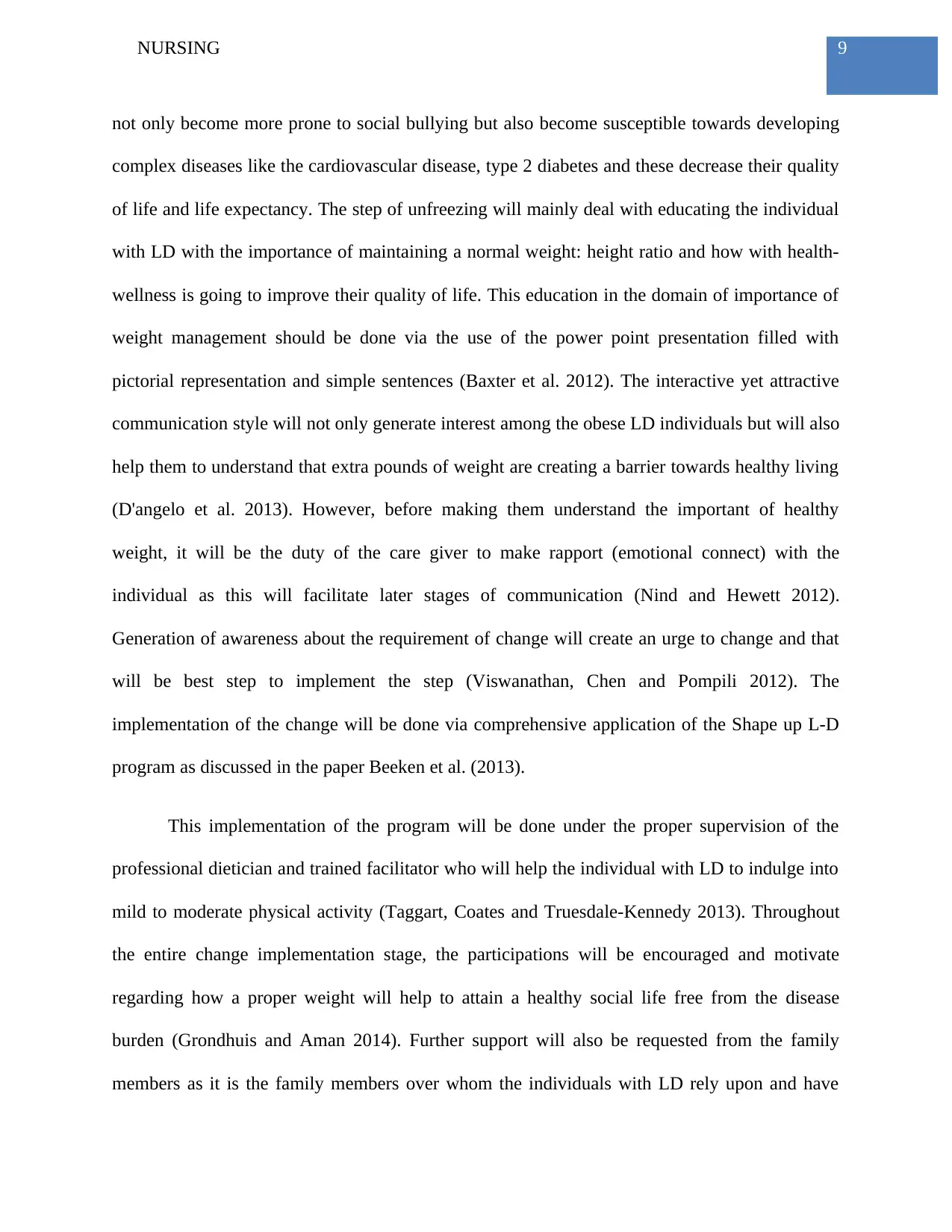
9NURSING
not only become more prone to social bullying but also become susceptible towards developing
complex diseases like the cardiovascular disease, type 2 diabetes and these decrease their quality
of life and life expectancy. The step of unfreezing will mainly deal with educating the individual
with LD with the importance of maintaining a normal weight: height ratio and how with health-
wellness is going to improve their quality of life. This education in the domain of importance of
weight management should be done via the use of the power point presentation filled with
pictorial representation and simple sentences (Baxter et al. 2012). The interactive yet attractive
communication style will not only generate interest among the obese LD individuals but will also
help them to understand that extra pounds of weight are creating a barrier towards healthy living
(D'angelo et al. 2013). However, before making them understand the important of healthy
weight, it will be the duty of the care giver to make rapport (emotional connect) with the
individual as this will facilitate later stages of communication (Nind and Hewett 2012).
Generation of awareness about the requirement of change will create an urge to change and that
will be best step to implement the step (Viswanathan, Chen and Pompili 2012). The
implementation of the change will be done via comprehensive application of the Shape up L-D
program as discussed in the paper Beeken et al. (2013).
This implementation of the program will be done under the proper supervision of the
professional dietician and trained facilitator who will help the individual with LD to indulge into
mild to moderate physical activity (Taggart, Coates and Truesdale‐Kennedy 2013). Throughout
the entire change implementation stage, the participations will be encouraged and motivate
regarding how a proper weight will help to attain a healthy social life free from the disease
burden (Grondhuis and Aman 2014). Further support will also be requested from the family
members as it is the family members over whom the individuals with LD rely upon and have
not only become more prone to social bullying but also become susceptible towards developing
complex diseases like the cardiovascular disease, type 2 diabetes and these decrease their quality
of life and life expectancy. The step of unfreezing will mainly deal with educating the individual
with LD with the importance of maintaining a normal weight: height ratio and how with health-
wellness is going to improve their quality of life. This education in the domain of importance of
weight management should be done via the use of the power point presentation filled with
pictorial representation and simple sentences (Baxter et al. 2012). The interactive yet attractive
communication style will not only generate interest among the obese LD individuals but will also
help them to understand that extra pounds of weight are creating a barrier towards healthy living
(D'angelo et al. 2013). However, before making them understand the important of healthy
weight, it will be the duty of the care giver to make rapport (emotional connect) with the
individual as this will facilitate later stages of communication (Nind and Hewett 2012).
Generation of awareness about the requirement of change will create an urge to change and that
will be best step to implement the step (Viswanathan, Chen and Pompili 2012). The
implementation of the change will be done via comprehensive application of the Shape up L-D
program as discussed in the paper Beeken et al. (2013).
This implementation of the program will be done under the proper supervision of the
professional dietician and trained facilitator who will help the individual with LD to indulge into
mild to moderate physical activity (Taggart, Coates and Truesdale‐Kennedy 2013). Throughout
the entire change implementation stage, the participations will be encouraged and motivate
regarding how a proper weight will help to attain a healthy social life free from the disease
burden (Grondhuis and Aman 2014). Further support will also be requested from the family
members as it is the family members over whom the individuals with LD rely upon and have
Paraphrase This Document
Need a fresh take? Get an instant paraphrase of this document with our AI Paraphraser
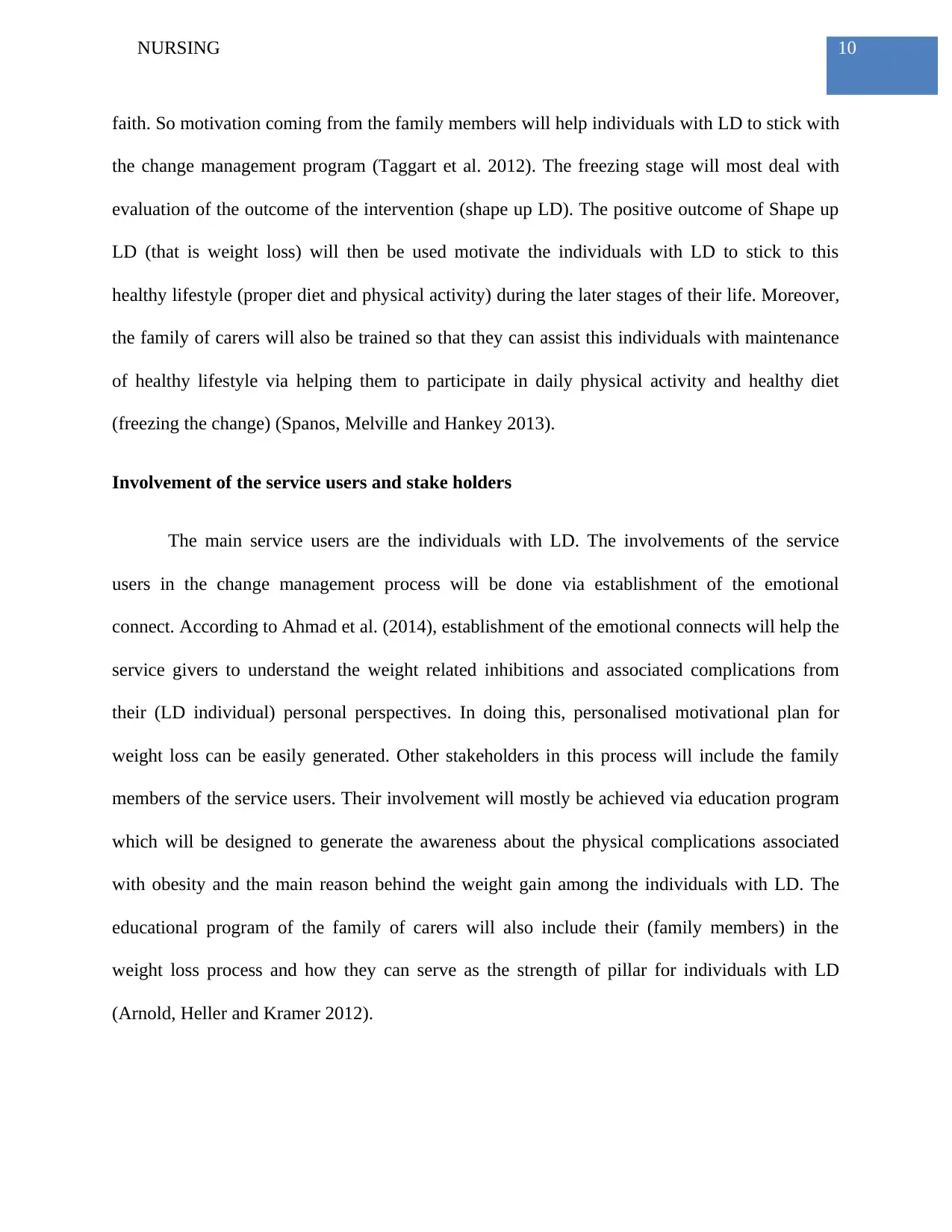
10NURSING
faith. So motivation coming from the family members will help individuals with LD to stick with
the change management program (Taggart et al. 2012). The freezing stage will most deal with
evaluation of the outcome of the intervention (shape up LD). The positive outcome of Shape up
LD (that is weight loss) will then be used motivate the individuals with LD to stick to this
healthy lifestyle (proper diet and physical activity) during the later stages of their life. Moreover,
the family of carers will also be trained so that they can assist this individuals with maintenance
of healthy lifestyle via helping them to participate in daily physical activity and healthy diet
(freezing the change) (Spanos, Melville and Hankey 2013).
Involvement of the service users and stake holders
The main service users are the individuals with LD. The involvements of the service
users in the change management process will be done via establishment of the emotional
connect. According to Ahmad et al. (2014), establishment of the emotional connects will help the
service givers to understand the weight related inhibitions and associated complications from
their (LD individual) personal perspectives. In doing this, personalised motivational plan for
weight loss can be easily generated. Other stakeholders in this process will include the family
members of the service users. Their involvement will mostly be achieved via education program
which will be designed to generate the awareness about the physical complications associated
with obesity and the main reason behind the weight gain among the individuals with LD. The
educational program of the family of carers will also include their (family members) in the
weight loss process and how they can serve as the strength of pillar for individuals with LD
(Arnold, Heller and Kramer 2012).
faith. So motivation coming from the family members will help individuals with LD to stick with
the change management program (Taggart et al. 2012). The freezing stage will most deal with
evaluation of the outcome of the intervention (shape up LD). The positive outcome of Shape up
LD (that is weight loss) will then be used motivate the individuals with LD to stick to this
healthy lifestyle (proper diet and physical activity) during the later stages of their life. Moreover,
the family of carers will also be trained so that they can assist this individuals with maintenance
of healthy lifestyle via helping them to participate in daily physical activity and healthy diet
(freezing the change) (Spanos, Melville and Hankey 2013).
Involvement of the service users and stake holders
The main service users are the individuals with LD. The involvements of the service
users in the change management process will be done via establishment of the emotional
connect. According to Ahmad et al. (2014), establishment of the emotional connects will help the
service givers to understand the weight related inhibitions and associated complications from
their (LD individual) personal perspectives. In doing this, personalised motivational plan for
weight loss can be easily generated. Other stakeholders in this process will include the family
members of the service users. Their involvement will mostly be achieved via education program
which will be designed to generate the awareness about the physical complications associated
with obesity and the main reason behind the weight gain among the individuals with LD. The
educational program of the family of carers will also include their (family members) in the
weight loss process and how they can serve as the strength of pillar for individuals with LD
(Arnold, Heller and Kramer 2012).
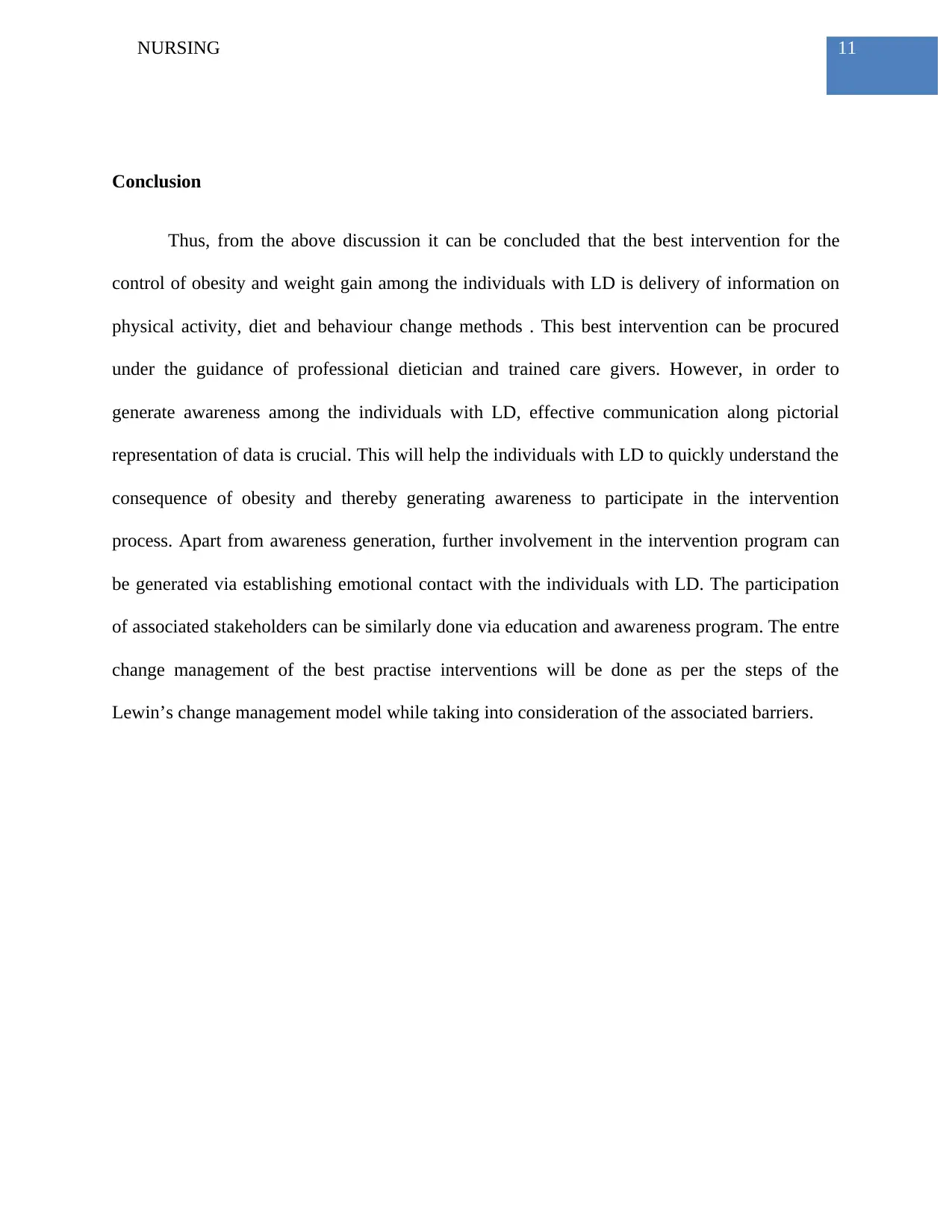
11NURSING
Conclusion
Thus, from the above discussion it can be concluded that the best intervention for the
control of obesity and weight gain among the individuals with LD is delivery of information on
physical activity, diet and behaviour change methods . This best intervention can be procured
under the guidance of professional dietician and trained care givers. However, in order to
generate awareness among the individuals with LD, effective communication along pictorial
representation of data is crucial. This will help the individuals with LD to quickly understand the
consequence of obesity and thereby generating awareness to participate in the intervention
process. Apart from awareness generation, further involvement in the intervention program can
be generated via establishing emotional contact with the individuals with LD. The participation
of associated stakeholders can be similarly done via education and awareness program. The entre
change management of the best practise interventions will be done as per the steps of the
Lewin’s change management model while taking into consideration of the associated barriers.
Conclusion
Thus, from the above discussion it can be concluded that the best intervention for the
control of obesity and weight gain among the individuals with LD is delivery of information on
physical activity, diet and behaviour change methods . This best intervention can be procured
under the guidance of professional dietician and trained care givers. However, in order to
generate awareness among the individuals with LD, effective communication along pictorial
representation of data is crucial. This will help the individuals with LD to quickly understand the
consequence of obesity and thereby generating awareness to participate in the intervention
process. Apart from awareness generation, further involvement in the intervention program can
be generated via establishing emotional contact with the individuals with LD. The participation
of associated stakeholders can be similarly done via education and awareness program. The entre
change management of the best practise interventions will be done as per the steps of the
Lewin’s change management model while taking into consideration of the associated barriers.
⊘ This is a preview!⊘
Do you want full access?
Subscribe today to unlock all pages.

Trusted by 1+ million students worldwide
1 out of 16
Related Documents
Your All-in-One AI-Powered Toolkit for Academic Success.
+13062052269
info@desklib.com
Available 24*7 on WhatsApp / Email
![[object Object]](/_next/static/media/star-bottom.7253800d.svg)
Unlock your academic potential
Copyright © 2020–2025 A2Z Services. All Rights Reserved. Developed and managed by ZUCOL.





